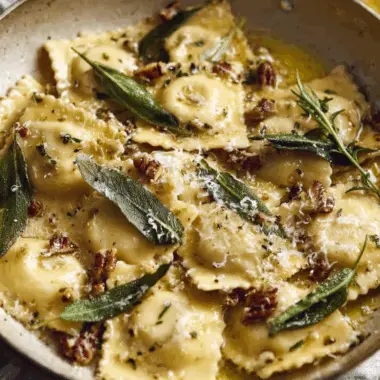This homemade Cannoli recipe offers a true Italian experience right at home. The crispy, deep-fried outer shell is filled with a luscious ricotta filling, dusted with powdered sugar, and topped with mini chocolate chips. It’s a delicious treat perfect for any special occasion or dessert craving, and you can even make up to 24 cannolis in one batch!
Full Recipe:
Ingredients
For the shell:
-
1 ¾ cups all-purpose flour
-
2 tablespoons granulated sugar
-
¼ teaspoon salt
-
2 tablespoons unsalted butter (cold)
-
1 egg yolk (reserve the whites)
-
⅓ cup marsala wine
-
1 teaspoon white vinegar
For the filling:
-
16 oz ricotta cheese (whole milk)
-
½ cup heavy whipping cream
-
½ cup powdered sugar
-
1 teaspoon vanilla extract
-
¼ teaspoon cinnamon
-
1 tablespoon mini chocolate chips
Directions
-
Pulse the flour, sugar, and salt in a food processor. Add cold butter and pulse until crumbly. Add marsala wine and egg yolk; mix until dough comes together.
-
Knead the dough on a floured surface until smooth, then chill in a covered bowl for 30-60 minutes.
-
Drain the ricotta using a fine mesh sieve for at least 30 minutes.
-
Whip the heavy cream in a medium bowl until stiff peaks form, then add powdered sugar. Mix into the ricotta mixture and chill.
-
Heat 5 inches of oil in a Dutch oven to 350°F.
-
Roll out dough and cut circles with a biscuit cutter. Wrap each circle around a cannoli mold, sealing with egg whites.
-
Fry the shells until golden, then remove from molds while still warm.
-
Fill the shells with the ricotta mixture using a piping bag. Top with mini chocolate chips and dust with powdered sugar.
Nutrients (per cannoli)
-
Calories: 116 kcal
-
Carbohydrates: 12g
-
Protein: 3g
-
Fat: 6g
-
Saturated Fat: 3g
-
Cholesterol: 26mg
-
Sodium: 43mg
-
Potassium: 39mg
-
Sugar: 4g
-
Vitamin A: 198 IU
-
Calcium: 46mg
-
Iron: 1mg
The Magic of Homemade Cannoli Shells
The outer shell of a cannoli is what makes this dessert stand out. A cannoli shell should be crispy, light, and perfectly fried. Achieving this requires a precise balance of ingredients, but the result is worth the effort. The dough is made by combining all-purpose flour, sugar, and salt. Adding cold butter ensures that the texture of the dough is crumbly and delicate. The addition of marsala wine and vinegar to the dough is a signature element in traditional cannoli recipes, giving the shells their signature flavor and helping them achieve a perfect golden brown when fried.
Rolling out the dough and cutting it into circles is the next step. This is where precision is important. The dough must be rolled thin enough so that when fried, it becomes crisp and light, but thick enough to hold the shape when wrapped around the cannoli mold. The dough is then wrapped around metal molds, sealed with egg whites, and fried in oil at a precise temperature to ensure the shells do not burn but instead reach a light golden color. This process is crucial to getting the perfect crunchy shell that will hold the creamy filling without becoming soggy.
The Creamy Ricotta Filling
The filling is the heart of any cannoli, and the key to getting it just right lies in the quality of the ricotta. For an authentic Italian taste, it’s important to use whole-milk ricotta cheese. The ricotta should be drained properly to remove excess moisture, ensuring that the filling remains thick and creamy. After draining the ricotta, it’s whipped together with heavy cream to achieve a light, airy texture. The heavy cream is whipped until stiff peaks form, creating a smooth and fluffy consistency that will perfectly complement the crunchy shell.
To enhance the flavor of the filling, powdered sugar is added for sweetness, while a touch of vanilla extract and cinnamon infuse it with warmth and depth. This combination of ingredients creates a balance of flavors that makes each bite of cannoli a mouthwatering experience. For added texture and flavor, mini chocolate chips are mixed into the filling, offering small bursts of sweetness in every bite.
Frying the Cannoli Shells: The Art of Perfection
Frying the cannoli shells is perhaps the most critical step in making this dessert. The shells need to be fried to a perfect golden brown, crispy on the outside while remaining light and hollow inside. This requires frying the dough at just the right temperature, usually around 350°F. If the oil is too hot, the shells may burn before they cook through. If the oil is too cool, they will become greasy and overly dense.
When frying, it’s important to carefully monitor the temperature of the oil. Frying the shells in batches ensures that the oil remains at a consistent temperature, which helps to achieve even cooking. After frying, the shells are removed from the molds while still warm. This is a crucial step, as removing them too late can make the shells difficult to remove and may result in them breaking. Once removed from the molds, the shells are left to cool and firm up, ready to be filled with the creamy ricotta mixture.
Assembling the Cannoli
Once the shells are fried and cooled, it’s time to assemble the cannoli. The filling is piped into the shells using a piping bag, ensuring that the ricotta mixture is evenly distributed throughout the entire length of the shell. The ends of the cannoli are often dipped in mini chocolate chips for added texture and flavor. The chocolate chips provide a delightful contrast to the rich, creamy filling and offer an extra touch of sweetness. After the filling is added and the chocolate chips are in place, the cannoli is dusted with powdered sugar for a finishing touch that adds both visual appeal and a sweet flavor.
The Role of Marsala Wine in the Shell
Marsala wine is a key ingredient in the dough for the cannoli shell, contributing both to the flavor and texture. It imparts a subtle sweetness and depth of flavor to the dough, which pairs beautifully with the rich, creamy ricotta filling. Marsala wine is a fortified wine from Sicily, and its use in traditional cannoli recipes adds authenticity to the dish. While it may not be a commonly used ingredient in other baking recipes, it plays a pivotal role in the success of the cannoli shell. For those who prefer a non-alcoholic version, non-alcoholic substitutes such as white grape juice can be used, though it may slightly alter the final flavor.
Tips for Making Perfect Cannoli at Home
Making cannoli at home is a rewarding experience, but it does come with a few challenges. Here are some tips to help you make the perfect cannoli:
-
Proper Shell Temperature: Always ensure that the oil is at the right temperature before frying. Using a thermometer will help you maintain a consistent heat and avoid overcooking or undercooking the shells.
-
Drain the Ricotta: Make sure to drain the ricotta well before using it in the filling. Excess moisture can result in a runny filling, which will make it difficult to pipe into the shells.
-
Filling Right Before Serving: To prevent the cannoli shells from becoming soggy, fill them with the ricotta mixture just before serving. This ensures that the shells retain their crisp texture and don’t become too soft.
-
Experiment with Fillings: While the traditional filling uses ricotta cheese, you can experiment with different flavors and ingredients, such as mascarpone or whipped cream, to create variations of the classic cannoli.
Conclusion: The Timeless Appeal of Cannoli
Cannoli is more than just a dessert; it’s a cultural tradition that brings people together to celebrate the flavors of Italy. Whether enjoyed as a special treat for a holiday or as a sweet finish to a family meal, cannoli never fails to delight. This homemade recipe captures the essence of the classic Sicilian dessert with its perfectly fried shells and creamy, flavorful ricotta filling. While making cannoli from scratch may take some time and patience, the results are undoubtedly worth the effort. By following these simple steps, you can create a dessert that transports you straight to Italy, offering a taste of Sicilian tradition in the comfort of your own home.








